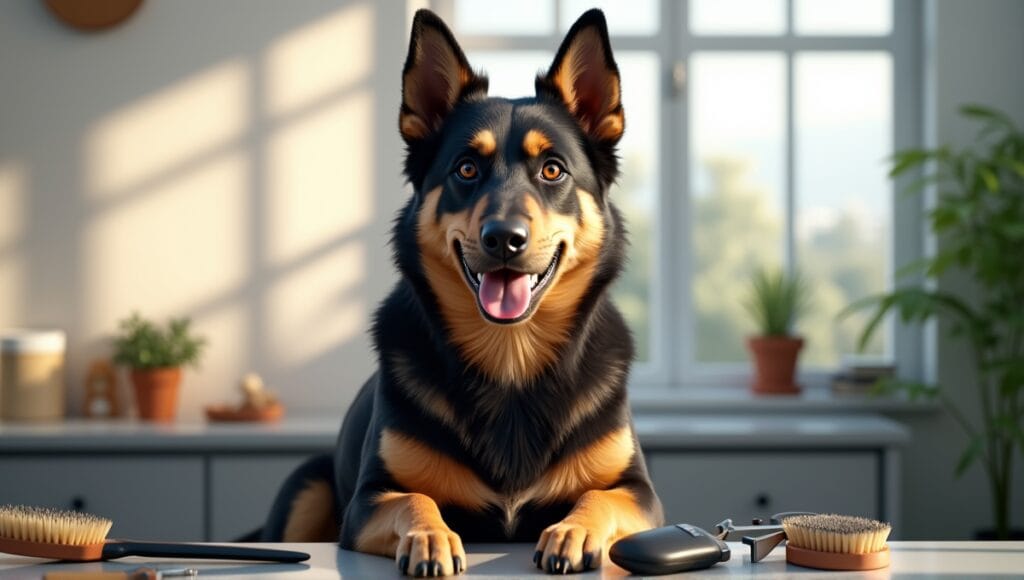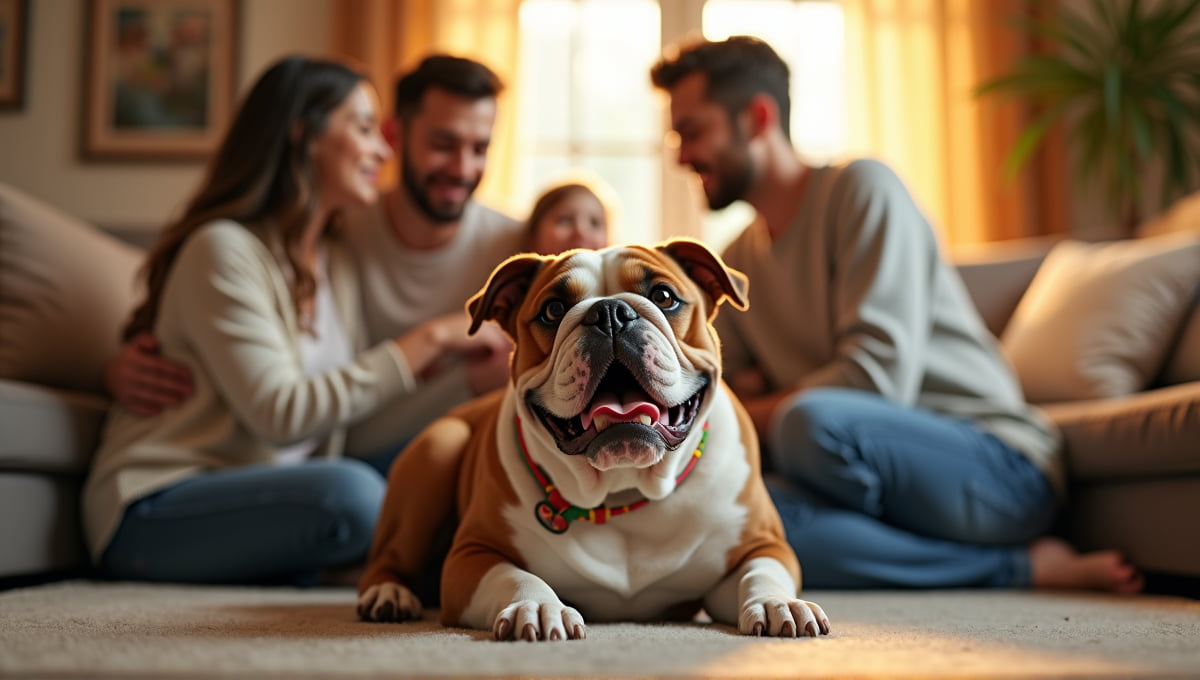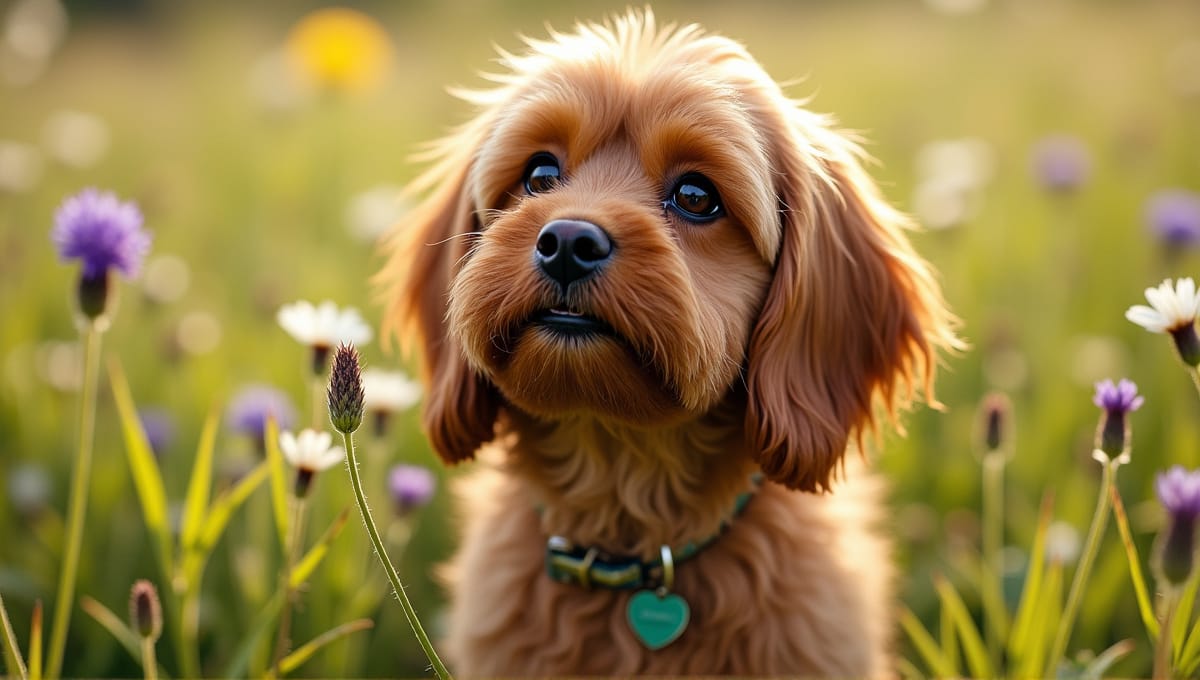Guard dogs that don’t shed are an excellent choice for people who want protection without constantly cleaning up dog hair. I have extensive experience with all of these breeds, and I can attest to their effectiveness as guard dogs. You’ll have the best of both worlds: a loyal guard dog and a clean house. So, without further ado, here are the top breeds.
Guard Dogs That Don’t Shed: Top Breeds for Protection and Cleanliness

You want a guard dog, but you don’t want to deal with constant shedding. I’ve got you covered. Here are the best big guard dog breeds that shed less.
Giant Schnauzer is at the top of our list. These dogs are strong and look very tall and intimidating. Their wiry coat sheds very little, and they’re excellent guard dogs. They’re also loyal and very intelligent.
If you don’t have a lot of space, you might consider a Standard Schnauzer. This breed offers the same guard capabilities in a smaller package. They often look alert, and their beard often makes them look distinguished.
Portuguese Water Dog is another great option as these dogs are versatile and hypoallergenic. While they excel in multiple roles, they also make great guard dogs. They do shed very little, though you will need to groom their curly coat regularly.
The Kerry Blue Terrier is another good option. These dogs are intelligent and definitely have a mind of their own, but their blue coat doesn’t shed much, and they have a strong protective instinct.
Many people are surprised to learn that Standard Poodles are great guard dogs. Despite the fancy haircuts, these dogs are highly intelligent, athletic, and extremely loyal. Their coat hardly sheds, making them a good option.
Airedale Terrier is the largest terrier breed and often referred to as the “King of Terriers.” These dogs are very courageous and versatile. Their wire coat doesn’t shed much, though it does require regular grooming.
Training Guard Dogs
Training a guard dog requires a significant investment of time, patience, and consistency. I’ve personally trained many dogs, and let me tell you that training a guard dog is one of the most rewarding experiences.
The best thing you can do for your guard dog is early socialization from 3 to 16 weeks. During this time, your puppy should meet as many different people, other animals, and target environments as possible to build confidence and learn the difference between a normal versus a threatening environment.
After socialization, basic obedience training is a must. Your dog should understand commands like sit, stay, come, and heel. These basic commands set the foundation for more advanced guard dog training.
A little more advanced guard dog training includes:
“Alert” command training
Boundary training
Controlled aggression training
Bite work (with professional help)
If you’re not an experienced trainer, consider hiring a professional. A professional may charge anywhere from $8,000 to $20,000 and training typically takes 2-4 months. Keep in mind most guard dogs require 2-3 years of constant training before they become fully capable working dogs.
Here’s a simple overview of the training process:
Socialization (3-16 weeks)
Obedience training (8-16 weeks)
Advanced obedience training (4-6 months)
Introducing guarding behavior (6-12 months)
Specialized guard dog training (1-2 years)
Consistent reinforcement and practice
Always remember that raising and training a guard dog is a massive responsibility, and safety should always be your first priority. When in doubt, seek advice from a professional.
Grooming and Maintenance for Non-Shedding Guard Dogs

Non-shedding breeds still require some grooming. Today, I want to discuss those grooming requirements.
Non-shedding doesn’t mean no maintenance. These breeds still need regular grooming to ensure their coats remain healthy and tangle-free.
Brushing is a must. Most non-shedding breeds require daily brushing to avoid matting and remove loose hair. Plus, it’s an excellent opportunity to bond with your dog.
Professional grooming is necessary every 6-8 weeks for non-shedding breeds. This includes trimming shaping and sometimes stripping the coat.
Bathing frequency varies by breed. As a general rule, bathing every 4-8 weeks is fine unless your dog gets exceptionally dirty. Any more frequent can dry out the skin.
Don’t overlook nail trimming and ear cleaning. Both should be done consistently to avoid discomfort and potential health problems.
Dental care is often forgotten, but it’s important. Ideally, you would brush your dog’s teeth every day, but even a few times per week will significantly impact your dog’s oral health.
Here’s a breakdown of grooming requirements by breed:
| Breed | Brushing Frequency | Professional Grooming | Bathing Frequency |
|---|---|---|---|
| Giant Schnauzer | Daily | Every 6-8 weeks | Every 6-8 weeks |
| Standard Schnauzer | 2-3 times per week | Every 6-8 weeks | Every 6-8 weeks |
| Portuguese Water Dog | Daily | Every 4-6 weeks | Every 4-6 weeks |
| Kerry Blue Terrier | 2-3 times per week | Every 6-8 weeks | Every 6-8 weeks |
| Standard Poodle | Daily | Every 4-6 weeks | Every 4-6 weeks |
| Airdale Terrier | 2-3 times per week | Every 6-8 weeks | Every 6-8 weeks |
Exercise Requirements for Guard Dogs That Don’t Shed
Guard dogs need a lot of exercise to be happy and balanced. Most of these breeds need at least 1-2 hours of exercise per day.
Physical exercise is important, but don’t forget mental stimulation. These are all intelligent breeds that require mental exercise as well as physical activity.
Exercise requirements will vary by breed. Poodles and Portuguese Water Dogs (for example) will need more intense exercise, while a Schnauzer might be happy with slightly less.
Balancing guard dog duties with exercise is key. A tired dog will be more alert and better able to perform its guarding duties effectively.
Here are a few exercise options for your guard dog:
- Long walks (or jogs)
- Fetch/frisbee
- Swimming (If you have a Portuguese Water Dog, this is essential).
- Agility
- Tug of war (with rules)
- Hide and seek with toys/treats
- Create an obstacle course
- Scent work
As a general rule, a tired dog is a good dog. Proper exercise will also prevent behavior problems and maintain your guard dog in superior condition.
Health Considerations for Non-Shedding Guard Dogs

Like all breeds, these dogs have certain health issues you should be concerned about.
Hip dysplasia is a concern in larger breeds, such as the Giant Schnauzer and Standard Poodle. You can catch this early with regular vet checkups.
Several of these breeds can suffer from eye issues like progressive retinal atrophy. So make sure to take them to the vet for regular eye exams.
Skin issues may be more prevalent in non-shedding breeds. Look for signs of allergies or skin issues.
Preventative care is the best option. This includes regular vaccinations, flea and tick prevention, and heartworm medication.
Their diet will be a significant factor in your dog’s health and performance. Ensure they get high-quality protein sources and a balanced diet for these active breeds.
The average lifespan for these guard dogs is about 10-12 years. However, many of the breeds listed can live even longer with proper care.
Here’s a comparison of health issues and lifespan:
| Breed | Common Health Issues | Average Lifespan |
|---|---|---|
| Giant Schnauzer | Hip dysplasia, eye issues | 10-12 years |
| Standard Schnauzer | Hip dysplasia, eye issues | 13-16 years |
| Portuguese Water Dog | Hip dysplasia, eye issues | 11-13 years |
| Kerry Blue Terrier | Eye issues, hypothyroidism | 12-15 years |
| Standard Poodle | Hip dysplasia, eye issues | 12-15 years |
| Airedale Terrier | Hip dysplasia, skin issues | 11-14 years |
Regular vet checkups and a healthy lifestyle will help your guard dog live a long, healthy life.
Living with Guard Dogs: Home Adaptations
There is some consideration and preparation involved in integrating a guard dog into your home.
You’ll also want to ensure you have a proper living space for your guard dog. This includes a comfortable bed, a designated eating spot, and somewhere they can relax.
You’ll also need to address safety concerns, especially if you have children or frequent guests.
Training and socialization is also an excellent way to reduce your guard dog’s protective tendencies.
It takes some work to integrate a guard dog into your family.
Again, the key is making sure your guard dog sees how they fit into the family dynamics.
Managing your guard dog’s protective tendencies in your home is a constant job.
Implement these tips to make your house more guard dog-friendly:
- Designate a “safe space” inside for your guard dog.
- Use a baby gate or crate as necessary.
- Provide plenty of chew toys to prevent them from getting destructive.
- Have rules about furniture and where the dog can and can’t go.
- Have a consistent routine with meals, exercise, and training.
- Properly introduce your guard dog to visitors to minimize protective reactions.
- You may also need professional help with specific home integration problems.
Keep in mind a guard dog that is properly integrated into a family can be an excellent protection dog and a loving family member.
Comparing Guard Dogs: Breed Characteristics

Here’s a quick overview of each breed to help you make a more educated decision.
Giant Schnauzers are the largest breed, standing 23.5-27.5 inches tall and weighing 55-85 pounds. They have a life expectancy of 12-15 years. These dogs are strong, impressive, and highly intelligent.
Standard Schnauzers are a bit smaller at 17.5-19.5 inches tall and 30-45 pounds. They can live 13-16 years. They’re watchful, fearless, and great watchdogs.
Portuguese Water Dogs range from 17-23 inches tall and 35-60 pounds. They typically live 11-13 years. They’re versatile, athletic, and eager to please.
Kerry Blue Terriers are another breed that stands 17.5-19.5 inches tall and weighs 33-40 pounds. They have a life expectancy of 12-15 years. These dogs are smart, strong-willed, and natural watchdogs.
Here’s a quick overview of these breed’s key characteristics:
| Breed | Height | Weight | Lifespan | Key Characteristics |
|---|---|---|---|---|
| Giant Schnauzer | 23.5-27.5″ | 55-85 lbs | 12-15 years | Strong, intelligent, loyal |
| Standard Schnauzer | 17.5-19.5″ | 30-45 lbs | 13-16 years | Alert, fearless, easy to train |
| Portuguese Water Dog | 17-23″ | 35-60 lbs | 11-13 years | Versatile, athletic, eager to please |
| Kerry Blue Terrier | 17.5-19.5″ | 33-40 lbs | 12-15 years | Intelligent, strong-willed, watchful |
Each breed has its own advantages. Choose the best option for your living situation, exercise ability, and grooming commitment. If you’re looking for more information on guard dogs, you might want to check out our article on the top 10 guard dogs to compare these non-shedding breeds with other popular guard dog options.
Let’s Close This Out
Guard dogs that don’t shed are the ultimate solution. You get protection and cleanliness. I’ve personally witnessed these breeds working as guard dogs on our farm. They are loyal, robust dogs. Training them requires patience, but it’s worth it. They look great with regular grooming. Exercise is essential to their overall health and happiness. Be aware of any breed-related health concerns. With proper care, these dogs make excellent family guard dogs. Select the breed that best aligns with your daily schedule, and you’ll have a loyal guard dog and a clean house for many years.






